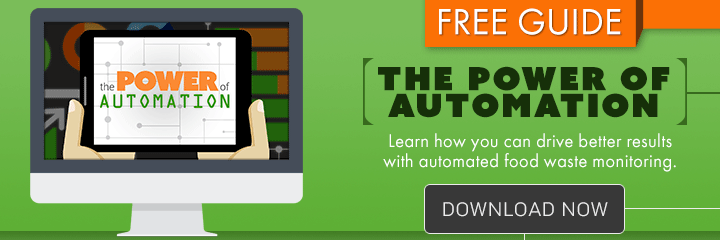Food Waste Prevention: A Key Opportunity Amid Rising Labor Costs

We all know that controlling costs is critical to running a successful business, especially in foodservice. Recently the cost of labor has been top-of-mind, as various pieces of legislation take effect to raise the minimum wage in certain parts of the United States. How to react to this challenge? After years of optimizing labor, operators have few opportunities to reduce labor without damaging their business in fundamental ways. Raising menu prices to offset the increases isn’t often viable, nor will it please customers. So what can foodservice operators do to manage the adverse impact of rising labor costs?
The key is finding efficiencies in other areas within the operation. And one often-overlooked area is food waste. Food waste prevention is an opportunity for cost reduction that can help operators offset increasing labor costs, all while bringing its own additional benefits.
Offsetting Labor Costs with Food Savings
Typically, at least 4 – 10% of all food purchased in foodservice is wasted before ever reaching a customer—that’s $40,000 to $100,000 for every $1 million in food purchases. Reducing pre-consumer food waste leads directly to higher food productivity and lower food costs, helping operators to offset the labor increases with savings on food spend. The food cost savings occur as operators change production, purchasing and menus to reduce waste. For example, by changing par levels or finding creative ways to merchandise food more efficiently, you can reduce food waste and costs. However, operations must first understand what foods they are wasting and why in order to make appropriate adjustments.
So how can businesses begin to understand their food waste stream? By tracking their food waste consistently and quickly every day. In addition to the food cost savings, food waste tracking actually helps with labor costs by motivating changes to production that reduce surplus food and the labor associated with that excess.
Wasted Food = Wasted Labor
We’ve written before that labor is one of the hidden costs of food waste. Along with the resources used to grow or produce, transport and store food, the labor invested to prepare food is all wasted when we toss that food in the garbage or compost it at the end of a meal period. By tracking food waste and identifying high-waste, often-overproduced food items, operations reduce wasted food but also the wasted embedded labor.
While tracking food waste manually can help reduce wasted labor invested in overproduced items, it takes some time to measure. This is where automated food waste tracking systems truly add value because they are streamlined and powerful. For most front-line employees, recording food waste with an automated system takes less than one minute per employee per day, and there is no managerial time required to transfer handwritten logs to a computer-based spreadsheet for analysis, as would be required with manual tracking. In fact, in a recent LeanPath survey, over 85% of respondents using both manual and automated systems affirmed that automated tracking requires less time and is easier than manual tracking.
Time Well Spent
While measurement of wasted food requires some focus and a little bit of time, the benefits are vast in comparison and the effort more than pays for itself, including the time cost for measuring.
Food waste tracking engages employees around the common goal of food waste prevention—a goal they very likely care about. It raises awareness of a critical issue that foodservice staff members are uniquely situated to address, it adds additional purpose to the work they do every day, and it makes the value of the ingredients they work with more vivid. We have heard time and time again that front-line staff that use LeanPath automated systems are amazed at the monetary value and environmental resource equivalencies of the food waste they record—these are some of the primary drivers of change.
An Unmissable Opportunity
The cost of labor will not decline from here forward, and we need our teams to run our businesses. For this reason, we encourage foodservice operators to confront finding adjacent efficiencies related to food waste, rather than focusing only on labor costs. The efficiencies are real, but so are the many other environmental and social benefits tied to preventing wasted food.
